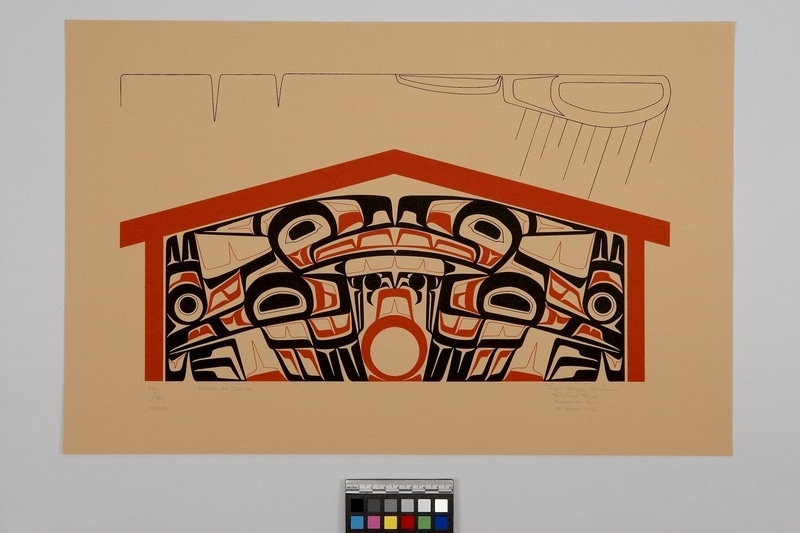House of James Item Number: Nb7.291 from the MOA: University of British Columbia

Description
Stylized image of a house front. Gabled roof and outside supports in red-orange bands. House front design is bilaterally symmetrical. Red-orange circle at centre bottom surmounted by a frontal face with circular eyes and tapering lines. Bird-like heads at the top meet at the centre with a red-orange wide teeth row. Other primary lines in black. Large black ovoid in ovoid below bird head and to the sides with split u's and wing-like shapes below. At the outside, there is a profile image with a black circle within circle eye-shape and two split u's to the top. Three digit paw ? to the bottom. U forms and split s-shapes in red line detail below. Above the house, there is black line drawing. The line across the top is split by deep v's. Below, there is an ovoid in ovoid on the right side with a u-shape to the left. Evenly spaced diagonal lines slope inward from the ovoid and the u-shape toward the roof of the house. Pencil inscription across the bottom edge reads '52/80 14/9/76 HOUSE OF JAMES Roy Henry Vickers TSIMSHIAN TRIBE KITKATLA B.C. St. JOHN 14 12'. The print is on a horizontally rectangular, brown paper stock.
History Of Use
Northwest Coast serigraphs are a contemporary art form, deriving from early 20th century drawings of traditional crest and decorative designs, commis- sioned by anthropologists and undertaken by artists such as Charles Edenshaw. Residential schools reinforced the medium, while discouraging the use of traditional themes. An important series of traditional designs in coloured pencil and watercolour were done by Mungo Martin for UBC in 1949-50. The 1960's saw the rapid growth of prints, first in unlimited poster editions, and later with the establishment of the Gitanmaax School of Northwest Coast Indian Art at 'Ksan (1967), and of the Northwest Coast Indian Artists Guild (1977), limited edition art runs became the standard. Northwest Coast silkscreen prints are part of the mainstream art market, as well as, functioning within the native context as potlatch gifts, and commemorative prints. Although, there are distinctive regional styles, individual artists may work in several styles, or apply unique themes and variations to specific works.
Iconographic Meaning
St. John 14:12.: Verily, verily, I say unto you, he that believeth in me, the works that I do shall he do also; and greater works than these shall he do; because I go unto my Father.
Cultural Context
contemporary art
Item History
- Made by Roy Henry Vickers (Maker) in British Columbia, Canada on September 14, 1976
- Owned by Norman Sandomirsky and Tobie Sandomirsky before June 27, 1984
- Received from Norman Sandomirsky (Donor) and Tobie Sandomirsky (Donor) on June 27, 1984
What
- Name
- House of James
- Identification Number
- Nb7.291
- Type of Item
- Manufacturing Technique
- silkscreened
- Overall
- height 33.0 cm, width 50.8 cm, depth 0.1 cm
Who
- Culture
- Tsimshian
- Creator
- Roy Henry Vickers (Maker)
- Previous Owner
- Norman Sandomirsky and Tobie Sandomirsky
- Received from
- Norman Sandomirsky (Donor) and Tobie Sandomirsky (Donor)
Where
- Holding Institution
- MOA: University of British Columbia
- Made in
- British Columbia, Canada
When
- Creation Date
- on September 14, 1976
- Ownership Date
- before June 27, 1984
- Acquisition Date
- on June 27, 1984
Other
- Item Classes
- works on paper
- Condition
- good
- Accession Number
- 0979/0005